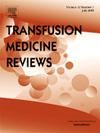单克隆抗 D 诱导低效逆转录酶:对预防胎儿和新生儿溶血病(HDFN)的意义
IF 2.5
2区 医学
Q2 HEMATOLOGY
引用次数: 0
摘要
导言/目的胎儿和新生儿溶血病(HDFN)是一种由母体 IgG 引起的同种免疫疾病,母体 IgG 穿过胎盘导致胎儿红细胞(RBC)破坏。供体来源的恒河猴免疫球蛋白(RhIG)是通过一种称为抗体介导的免疫抑制(AMIS)的现象来预防 HDFN 的唯一许可方案。RhIG诱导AMIS的机制尚不清楚,这阻碍了替代RhIG的单克隆抗体的成功开发。 我们最近的小鼠数据表明,逆转录细胞诱导的抗原丢失可能在AMIS诱导中起核心作用。本研究旨在比较临床评估的抗 D 单克隆抗体与 RhIg 相比在 AMIS 条件下促进体外逆转录吞噬的能力。设计与方法用 PKH67 荧光标记 RhD+ 人红细胞(RBC),并用不同浓度的 RhIG(WinRho、SDF)或 IgG1 BRAD5 单克隆抗 D 抗体致敏。敏化与未敏化的红细胞分别与或不与 THP-1-CD16A 巨噬细胞孵育 30 分钟和 3 小时。回收荧光红细胞,清洗巨噬细胞,裂解剩余的红细胞。评估 BRAD5 与 RhIG 诱导 RBC 膜荧光消失和 RBC 膜转移到巨噬细胞(即逆转吞噬)以及吞噬的能力。流式细胞术测定了回收的 RBC 上 PKH67 的中值荧光强度(MFI)、PKH67+巨噬细胞的百分比及其 PKH67 MFI。结果我们观察到,用≥110 ng/mL的RhIG致敏的RBC表现出明显的吞噬作用,而较低浓度的RhIG则主要表现出明显的逆转录酶驱动的抗原丢失。由于注射 RhIG 的患者血浆中抗 D 的理论浓度低于 100 毫微克/毫升,我们的研究结果表明,在 AMIS 条件下,逆吞噬作用可能是体内机制。就 BRAD5 而言,该抗体与 RhIg 一样,既能诱导吞噬作用,也能诱导逆行细胞吞噬作用。然而,与 RhIg 相比,BRAD5 需要更高的浓度才能实现相当程度的逆行细胞吞噬。相反,BRAD5 单克隆抗体虽然能诱导逆行细胞吞噬,但其效率比 RhIG 低十倍以上,这反映了其在先前的临床研究中预防 RhD 同种免疫的效果较差。本文章由计算机程序翻译,如有差异,请以英文原文为准。
Monoclonal anti-D induces low efficiency trogocytosis: Implications for the prevention of Hemolytic disease of the fetus and newborn (HDFN)
Introduction/Objective
Hemolytic disease of the fetus and newborn (HDFN) is an alloimmune condition provoked by maternal IgG that crosses the placenta and causes fetal red blood cell (RBC) destruction. Donor-derived Rhesus Immune Globulin (RhIG) is the only licensed option available to prevent HDFN through a phenomenon called antibody-mediated immune suppression (AMIS). The mechanism as to how RhIG induces AMIS is poorly understood and this has hampered the successful development of monoclonal antibodies to replace RhIG. Our recent murine data suggests that trogocytosis-induced antigen loss could play a central role in AMIS induction. The present work aims to compare the ability of anti-D monoclonal antibody, clinically assessed, to promote in vitro trogocytosis under AMIS conditions compared with RhIg.
Design and Methods
RhD+human RBCs (RBCs) were fluorescently labeled with PKH67 and sensitized with different concentrations of RhIG (WinRho, SDF) or the IgG1 BRAD5 monoclonal anti-D antibody. Sensitized vs non-sensitized RBCs were incubated with or without THP-1-CD16A macrophages for 30 min and 3 hours. Fluorescent RBCs were recovered, macrophages washed, and remaining RBCs lysed. The ability of BRAD5 vs RhIG to induce RBC membrane fluorescence loss and RBC membrane transfer to the macrophages (ie., trogocytosis) as well as phagocytosis were evaluated. Median fluorescence intensity (MFI) of PKH67 on the RBC recovered, the percentage of PKH67+ macrophages, as well as their PKH67 MFI, were determined by flow cytometry. Confocal cell microscopy to visualize the interaction between macrophages and anti-D sensitized RBCs was performed.
Results
We observed that RBCs sensitized with ≥110 ng/mL of RhIG showed significant phagocytosis while lower concentrations primarily demonstrated significant trogocytosis-driven antigen loss. As the theoretical plasma concentration of anti-D in patients administered RhIG is below 100 ng/mL, our findings indicate that trogocytosis is the probable in vivo mechanism under AMIS conditions. In the case of BRAD5, this antibody, like RhIg, was capable of inducing both phagocytosis and trogocytosis. However, much higher concentrations of BRAD5 were necessary to achieve a comparable degree of trogocytosis as compared to RhIg.
Conclusions
This work demonstrates that RhIG has the capacity to induce trogocytosis at clinically relevant concentrations, with minimal to no phagocytosis. Conversely, the BRAD5 monoclonal antibody although capable of trogocytosis, was over ten times less efficient than RhIG, mirroring its poorer efficacy in prior clinical studies for preventing RhD alloimmunization.
求助全文
通过发布文献求助,成功后即可免费获取论文全文。
去求助
来源期刊

Transfusion Medicine Reviews
医学-血液学
CiteScore
11.60
自引率
0.00%
发文量
40
审稿时长
21 days
期刊介绍:
Transfusion Medicine Reviews provides an international forum in English for the publication of scholarly work devoted to the various sub-disciplines that comprise Transfusion Medicine including hemostasis and thrombosis and cellular therapies. The scope of the journal encompasses basic science, practical aspects, laboratory developments, clinical indications, and adverse effects.
 求助内容:
求助内容: 应助结果提醒方式:
应助结果提醒方式:


